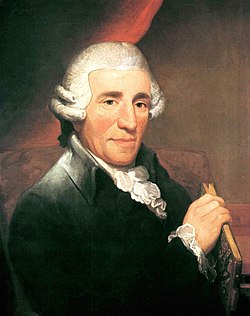
Symphony No. 67 in F major, Hoboken I/67, is a symphony by Joseph Haydn. It was composed by 1779. The Haydn scholar H. C. Robbins Landon calls this work "one of the most boldly original symphonies of this period." [1]

Symphony No. 67 in F major, Hoboken I/67, is a symphony by Joseph Haydn. It was composed by 1779. The Haydn scholar H. C. Robbins Landon calls this work "one of the most boldly original symphonies of this period." [1]
The work is scored for two oboes, two bassoons, two horns and strings. [1] There are four movements:
This is the only symphony where Haydn opens in fast 6
8 time without a slow introduction. [2]
At the end of the second movement, the entire string section is directed to play col legno dell'arco (with the wood of the bow). [1]
The trio of the minuet is scored for two solo violins each playing con sordino on single strings. The first violin plays the melody on the E string and the second violin tunes its G string down to F and plays a drone on the open string. [3]
The closing Allegro di molto departs from the standard finale form. It features its own internal Adagio e cantabile slow movement. The fast music is first interrupted by a solo string trio (two violins and cello) instructed to play piano e dolce. [1] The rest of the orchestra elaborates on this slow section, including some passages for the string trio's woodwind counterparts (two solo oboes and a bassoon), [2] before the initial Allegro di molto section returns and Haydn brings the symphony to its conclusion.